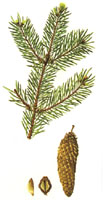View crop
View crop Data sheet EcoPortPicea abies
 |
|
| Notes |
|---|
| DESCRIPTION: Norway spruce is an evergreen tree reaching a height of 30-60 m. The bole is usually straight and symmetrical, with no tendency to fork. The root system is typically shallow, with several lateral roots and no taproot. On rocky sites the roots spread widely, twining over the rocks. On bog soils, it tends to form plate-like roots. USE: The wood is strong, soft, straight- and fine-grained, and easily worked. It is not durable in contact with soil. It is widely used for construction, pulp, furniture, and musical instruments. Planted in shelter belts and as an ornamental. GROWING PERIOD: Perennial. COMMON NAMES: Norway spruce (England), Gran (Norway), Rød gran (Denmark), Metsäkuusi (Finland), Fichte (Germany). FURTHER INF: It grows best in cool, humid climates on rich soils. Preferred soils include well-drained sandy loams. It also grows well on almost all other types of soils. Permanently waterlogged soils inhibit growth, but it does occur on poorly drained soils and in bogs. Growth rates increase with increased soil organic material and are positively correlated to the nitrogen content of the soil. Soil pH often ranged from 3.7 to 4.4. It occurs at elevations up to 2000 m in the Bavarian Alps. It is tolerant of shade but not very wind firm. | Sources |